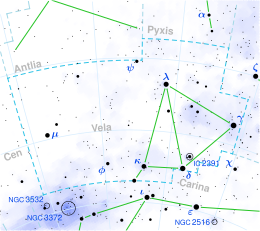| Observation data Epoch J2000 Equinox J2000 | |
|---|---|
| Constellation | Centaurus [1] |
| Right ascension | 11h 12m 10.18976s [2] |
| Declination | −46° 16′ 00.3202″ [2] |
| Apparent magnitude (V) | 6.27±0.01 [3] |
| Characteristics | |
| Spectral type | A1 V [4] |
| U−B color index | +0.04 [5] |
| B−V color index | +0.15 [5] |
| Astrometry | |
| Proper motion (μ) | RA: −46.711 mas/yr [2] Dec.: +9.593 mas/yr [2] |
| Parallax (π) | 10.1866±0.155 mas [2] |
| Distance | 320 ± 5 ly (98 ± 1 pc) |
| Absolute magnitude (MV) | +1.5 [1] |
| Details | |
| A | |
| Mass | 1.94±0.11 [6] M☉ |
| Radius | 2.18+0.05 −0.08 [7] R☉ |
| Luminosity | 19.6 [8] L☉ |
| Surface gravity (log g) | 4.07±0.05 [6] cgs |
| Temperature | 7,800 [8] K |
| Metallicity [Fe/H] | −0.29 [9] dex |
| Other designations | |
| CD−45°6771, CPD−45°5279, GC 15400, HD 97413, HIP 54718, SAO 222635, WDS J11122-4616AB [10] | |
| Database references | |
| SIMBAD | data |
HD 97413 is a binary star located in the southern constellation Centaurus. The system has a combined magnitude of 6.27, [3] placing it near the limit for naked eye visibility. Based on parallax measurements from the Gaia spacecraft, the system is located 320 light years away from the Solar System. [2]
The objects binarity was detected in a Hipparcos survey. The two components can't be distinguished because both stars have an angular separation of 0.01″ . [11] Nevertheless, speckle interferometry revealed the components to have a 2.6 magnitude difference. [12] They are located along a position angle of 250°. [11]
The visible component – HD 97413 A – has a stellar classification of A1 V, indicating that it is an ordinary A-type main-sequence star. It has 1.94 times the mass of the Sun [6] and a radius of 2.18 R☉. [7] It radiates 19.6 times the luminosity of the Sun [8] from its photosphere at an effective temperature of 7,800 K , [8] giving it a white hue. However, this is not typical for an A1 star. Parameters determined by Gaia's extinction reveal HD 97413 A to have an iron abundance half of the Sun's, [9] making it metal deficient.
